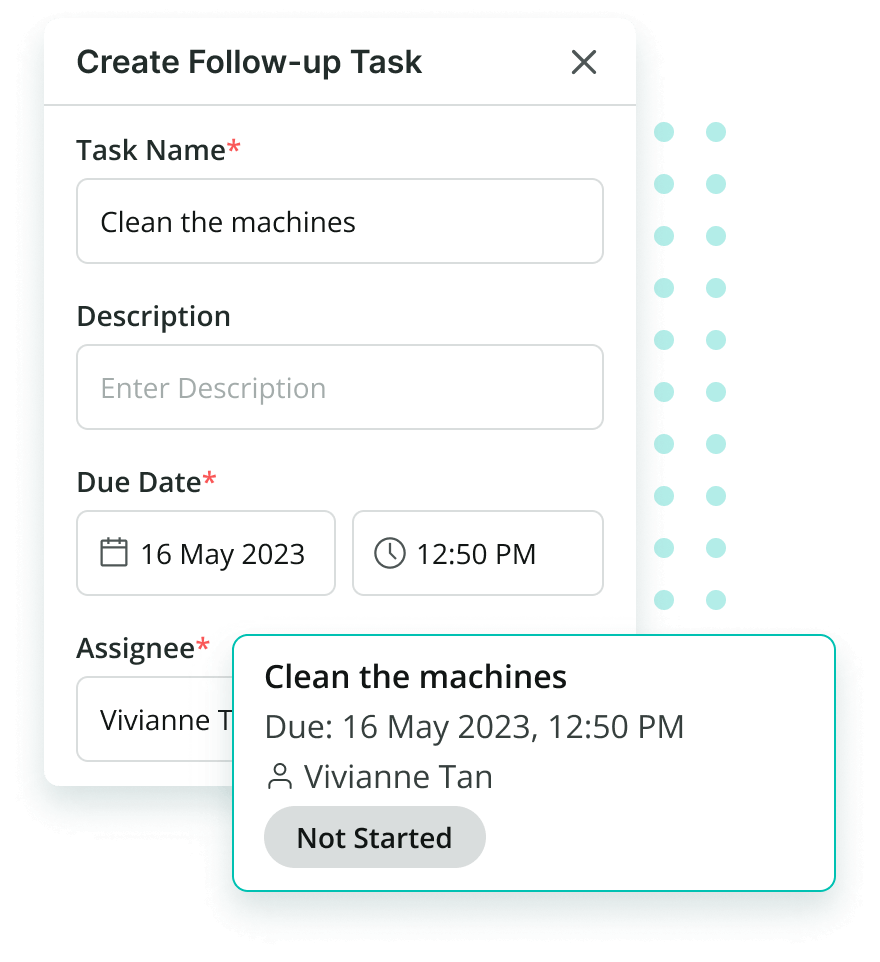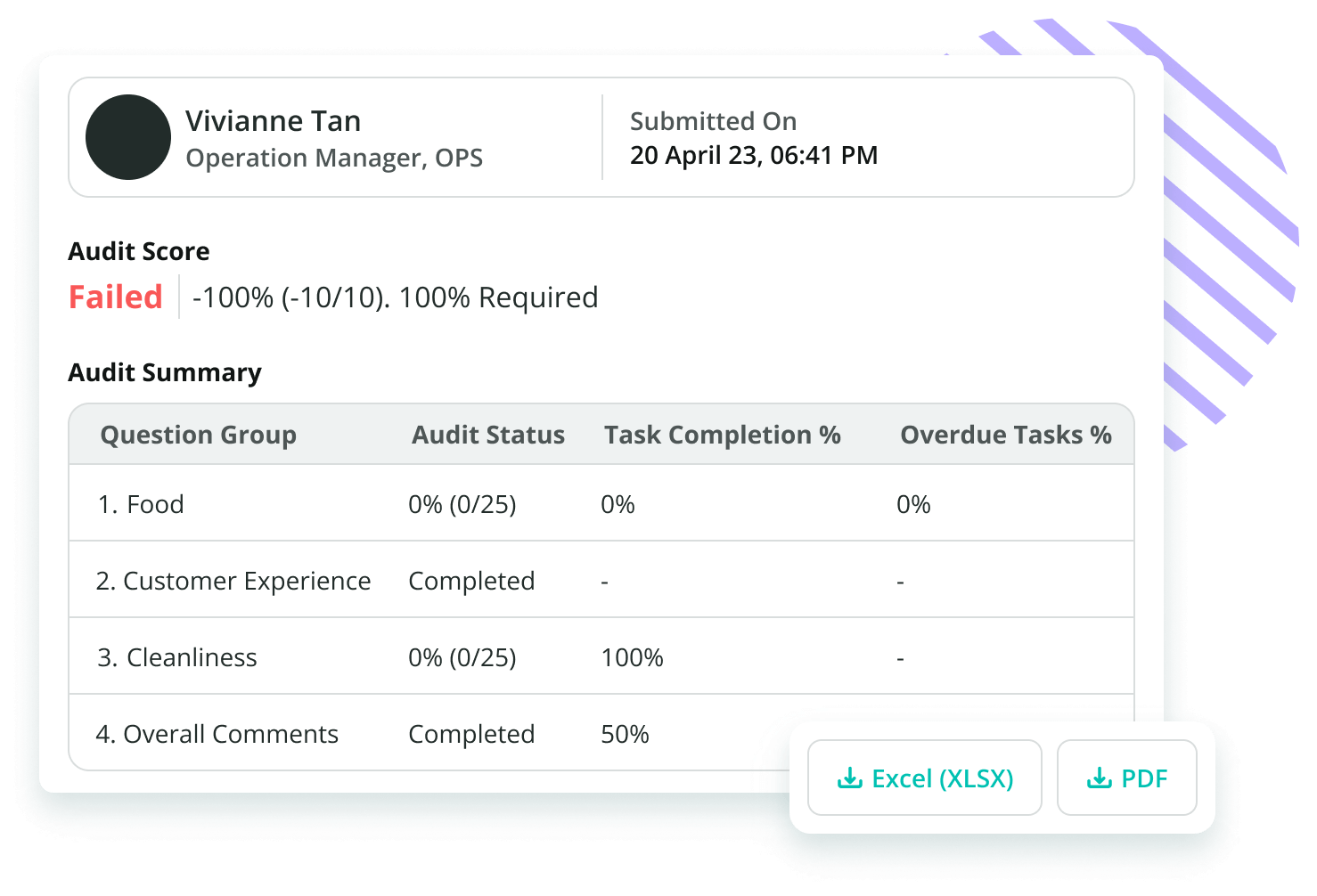The Centers for Disease Control and Prevention (CDC) reports that foodborne illnesses affect 48 million Americans annually. That’s roughly one in six people. For food businesses, ensuring food safety compliance is more than a legal obligation—it’s a vital responsibility.
Food safety audits evaluate how well a business meets food safety standards, identifying risks that could lead to contamination. Experienced food safety professionals, particularly food safety auditors, are essential for conducting thorough evaluations of food businesses’ compliance with food safety laws.
These audits safeguard public health, strengthen trust, and help businesses maintain compliance with regulations like the FDA’s Food Safety Modernization Act (FSMA) and the Hazard Analysis and Critical Control Points (HACCP) system.
What is a Food Safety Audit?
A food safety audit is a systematic evaluation of a food business’s food safety management system to ensure compliance with food safety standards and regulations. This crucial process helps identify potential risks and areas for improvement, ensuring the safety and quality of food products.
Key Points
- Ensuring Food Safety & Compliance: Food safety audits prevent contamination, ensure compliance with FDA’s FSMA and HACCP regulations, and help businesses avoid costly penalties.
- Types of Audits: Internal audits assess in-house practices, supplier audits verify ingredient safety, regulatory audits ensure legal adherence, and third-party audits provide independent certification.
- Key Focus Areas: Audits evaluate sanitation, employee hygiene, food storage, pest control, documentation, and recall procedures to maintain high safety standards.
- Audit Preparation & Execution: Businesses should conduct self-assessments, train staff, maintain records, cooperate with auditors, and implement corrective actions after audits.
- Common Failures & Solutions: Poor documentation, improper sanitation, untrained staff, and cross-contamination risks lead to audit failures, which can be prevented with proper protocols.
- Benefits of Compliance: Passing audits builds customer trust, enhances brand reputation, improves operational efficiency, and provides a competitive market advantage.
Types of Food Safety Audits
Food safety audits help businesses follow hygiene rules and keep food safe for consumers. Conducting a food safety audit involves critical steps necessary for evaluating and ensuring compliance with food safety standards. Different audits focus on various areas, ensuring that food production and supply chains maintain high safety standards. Here are the main types of food safety audits:
1. Internal Audits
Internal audits are conducted within a company by its own food safety team. These audits help businesses check their food safety practices, identify risks, and fix problems before external inspections occur.
By reviewing daily operations, internal audits ensure that food is handled, stored, and processed safely. They also help businesses follow food safety management systems like HACCP (Hazard Analysis and Critical Control Points). Regular internal audits create a culture of accountability and help avoid major safety issues.
2. Supplier Audits
Businesses rely on suppliers to provide quality ingredients, making supplier audits essential. These audits check whether suppliers meet food safety standards and follow the company’s safety protocols.
Supplier audits help ensure that raw materials are safe before they reach the company’s production process. Companies often perform these audits to maintain consistency and prevent contamination from unsafe ingredients. If a supplier fails an audit, the company may look for an alternative source to maintain food quality and safety.
3. Regulatory Audits
Regulatory audits are carried out by government agencies such as the FDA (Food and Drug Administration), USDA (United States Department of Agriculture), or local health departments.
These audits ensure that businesses follow national and regional food safety laws. Inspectors check food handling, storage, hygiene, and overall safety compliance. Failing a regulatory audit can lead to serious consequences, including fines, food recalls, or business shutdowns. To pass these audits, businesses must always follow proper food safety procedures and maintain clear records of their practices.
4. Third-Party Audits
Third-party audits are conducted by independent organizations like the Global Food Safety Initiative (GFSI), Safe Quality Food (SQF), or ISO 22000. These audits provide an unbiased evaluation of a company’s food safety systems.
Third-party audits help businesses gain industry certifications, which improve their reputation and customer trust. Many retailers and food service providers require their suppliers to pass third-party audits to ensure food safety throughout the supply chain.
Each type of food safety audit plays a crucial role in protecting consumers and maintaining high safety standards in the food industry.
Key Components of a Food Safety Audit
Food safety audits examine different areas of a food business to ensure cleanliness, hygiene, and compliance with safety standards. By following strict procedures, businesses can reduce contamination risks and maintain food quality. The food safety audit process is a critical evaluation performed by food safety auditors to ensure compliance with food safety laws and regulations. Here are the most important areas covered in a food safety audit:
1. Facility and Equipment Sanitation
A clean workspace is essential for food safety. Auditors check if all surfaces, machinery, and utensils are properly cleaned and sanitized. If equipment is not cleaned well, bacteria and food residue can build up, leading to contamination. Businesses must follow strict cleaning schedules and use approved sanitizers to meet safety standards.
2. Employee Hygiene and Training
Employees play a major role in food safety. Auditors assess whether staff follow hygiene policies, such as wearing gloves, washing hands, and keeping their uniforms clean. They also check if employees are trained in food safety practices. Proper training ensures that workers understand the risks of contamination and know how to handle food safely. A strong food safety culture starts with well-trained staff.
3. Food Storage and Handling
Proper food storage is necessary to prevent spoilage and contamination. Auditors check if businesses store food at the right temperatures and label products correctly. FIFO (First In, First Out) is a common method used to ensure older food is used before newer stock. Improper storage can lead to foodborne illnesses, so businesses must monitor their storage systems carefully.
4. Pest Control Measures
Pests like rodents and insects can spread diseases and contaminate food. A food safety audit examines whether businesses have effective pest control measures in place. This includes sealing entry points, using traps, and keeping storage areas clean. Regular pest inspections help prevent infestations and ensure food safety.
5. Recordkeeping and Documentation
Maintaining accurate records is essential for proving compliance with food safety regulations. Auditors review logs that track cleaning schedules, temperature checks, employee training, and food deliveries. Good recordkeeping shows that a business is consistently following safety procedures.
6. Traceability and Recall Procedures
If food contamination occurs, businesses must be able to trace the problem and recall affected products quickly. Auditors check if companies have systems to track food sources and respond to safety incidents. A well-managed recall process helps protect consumers and prevent further issues.
By focusing on these areas, food businesses can improve their safety standards and ensure compliance with regulations.
Stages of Food Safety Audit
Preparing for a food safety audit requires careful planning and attention to detail. A well-prepared business can ensure smooth operations and compliance with food safety regulations. The preparation process can be divided into three key stages: before, during, and after the audit. Food safety auditing is crucial in improving practices, ensuring public health protection, and achieving compliance with regulatory standards throughout the food supply chain.
Stage 1: Before the Audit
The first step in preparing for a food safety audit is conducting self-assessments. Businesses should evaluate their own food safety practices to identify potential risks and fix any issues before the official audit. Training staff is also an important part of preparation.
Employees should be educated on personal hygiene, food handling, and sanitation procedures to ensure they follow safety guidelines. Another critical aspect is maintaining proper documentation.
Food businesses must keep updated records of their safety procedures, including cleaning schedules, temperature logs, and employee training records. Reviewing previous audit reports is also essential. Businesses should check past findings, correct any mistakes, and implement improvements to avoid repeating errors.
Stage 2: During the Audit
When the audit takes place, businesses must be cooperative and transparent. Auditors should be given full access to inspect facilities, equipment, and food storage areas. Businesses should be open about their processes and willing to answer questions honestly.
Key personnel, such as food safety managers or supervisors, should be available to discuss company policies and provide necessary documents. Good communication during the audit shows that a business is serious about food safety and compliance.
Satge 3: After the Audit
Once the audit is complete, businesses should carefully review the findings. If any issues are identified, corrective actions should be taken immediately to improve compliance. Changes may include updating cleaning routines, retraining staff, or improving storage practices.
It is also important to document all improvements made after the audit. Keeping track of these changes will help businesses perform better in future audits and maintain high food safety standards.
By following these steps, businesses can prepare effectively for food safety audits, ensuring compliance and protecting consumer health.
Common Food Safety Audit Mistakes – Avoidable
Food safety audits are vital for ensuring that food businesses adhere to hygiene and safety standards. Unfortunately, many businesses fail these audits due to avoidable mistakes. By understanding these common pitfalls and taking preventive measures, businesses can pass audits successfully and maintain a safe environment for food handling. Food safety audits focus on critical areas within restaurant operations to ensure compliance with safety protocols.
Here are key reasons why businesses may fail a food safety audit:
- Inadequate Documentation: Without proper records of temperature logs, cleaning schedules, and compliance checks, auditors may conclude that food safety procedures are not being followed.
- Poor Sanitation Practices: Unclean surfaces, outdated cleaning records, or improper sanitation methods can result in audit failures.
- Untrained Staff: Employees must be knowledgeable about proper food handling, hygiene, and safety procedures to prevent contamination.
- Cross-Contamination Risks: It is essential to store and handle raw and cooked foods separately to avoid bacterial spread.
- Non-Compliance with Regulations: Staying up-to-date with food safety laws and updates is crucial to prevent violations and penalties.
By proactively addressing these issues, food businesses can enhance their safety practices and ensure a successful food safety audit.
Benefits of a Successful Food Safety Audit
Achieving a high food safety standard comprises multiple advantages:
| Benefit | Impact on Business |
|---|---|
| Regulatory Compliance | Ensures adherence to food safety regulations, preventing costly penalties and fines. By maintaining compliance, businesses can operate smoothly without interruptions from regulatory authorities. |
| Enhanced Brand Trust | Builds a strong food safety culture, which enhances the brand’s reputation and reliability. Consumers are more likely to trust and choose brands known for prioritizing food safety, leading to increased customer loyalty and market share. |
| Reduced Foodborne Risks | Lowers the incidence of contamination and foodborne illnesses, safeguarding public health. By minimizing these risks, businesses can avoid negative publicity and potential legal issues, ensuring a safer food supply chain. |
| Operational Efficiency | Streamlines workflow and optimizes food safety tasks, leading to more efficient operations. Improved efficiency can result in cost savings and better resource management, contributing to overall business growth. |
| Competitive Advantage | Provides a significant edge over competitors by increasing customer confidence and satisfaction. Businesses that consistently demonstrate high food safety standards can differentiate themselves in the market, attracting more clients and partners. |
These benefits prove that prioritizing food safety audits is a smart investment for any food business. Audits play a crucial role in evaluating the effectiveness of the food business management system in preventing contaminated food from entering the market.
How KNOW Can Help You Through a Food Safety Audit
KNOW offers significant advantages by digitizing and streamlining each step. With KNOW, you can effortlessly maintain compliance, ensure accurate record-keeping, and remain audit-ready at all times.
- Comprehensive Audit Management – Manage all types of audits seamlessly on one platform, from pest control to equipment quality, ensuring thorough and efficient oversight.
- Efficient Audit Scheduling – Automate recurring audit schedules, capture pass/fail scores, and eliminate the risk of overlooked tasks.
- Effective Issue Resolution – Assign and track remedial actions for any failed audit items, ensuring quick resolution and closing compliance gaps.
- Instant Report Generation – Access a centralized digital repository for all audits, enabling quick reviews and verification of compliance.


Stay audit-ready with KNOW.
Book a Free Demo
Frequently Asked Questions about Food Safety Audits
1. How to prepare for a food safety audit?
First, conduct thorough self-assessments to identify and address potential risks in your food safety practices. Train your staff on essential hygiene and safety protocols to ensure they are well-prepared for the audit. Maintain meticulous records of all safety procedures, including cleaning schedules, temperature logs, and employee training records. Review previous audit reports to identify areas for improvement and make necessary changes. During the audit, be transparent and cooperative with the auditors, providing them with full access to facilities and documentation.
2. What is an internal food safety audit?
An internal food safety audit is conducted within a company by its own food safety team. The purpose of this audit is to evaluate the company’s food safety practices, identify risks, and address any issues before external inspections occur. Internal audits focus on reviewing daily operations to ensure that food is handled, stored, and processed safely. They also help businesses adhere to food safety management systems such as HACCP, fostering a culture of accountability and preventing major safety issues.
3. What are the record-keeping requirements for food safety records and audit reports?
Record-keeping requirements for food safety records and audit reports include maintaining accurate and up-to-date documentation of all safety procedures.
This includes cleaning schedules, temperature logs, employee training records, and food delivery logs. Businesses must ensure that these records are easily accessible and organized for review during audits. Proper record-keeping demonstrates compliance with food safety regulations and helps identify areas for improvement in food safety practices.
4. Who can conduct a food safety audit?
A food safety audit can be conducted by various entities, depending on the type of audit. Internal audits are performed by the company’s own food safety team. Supplier audits may be conducted by the company’s procurement or quality assurance team. Regulatory audits are carried out by government agencies such as the FDA or USDA. Third-party audits are conducted by independent organizations like the Global Food Safety Initiative (GFSI) or Safe Quality Food (SQF) certification bodies. Each auditor brings a unique perspective and expertise to evaluate food safety compliance.
5. Why is a food safety audit important?
A food safety audit is important because it helps prevent food contamination, ensures compliance with food safety regulations, and protects public health. By identifying potential risks and areas for improvement, audits help businesses maintain high safety standards and avoid costly penalties. Successful audits enhance customer trust, improve brand reputation, and provide a competitive edge in the market. Ultimately, food safety audits are essential for safeguarding consumers and ensuring the quality of food products.
6. What are the different types of food safety audits?
There are several types of food safety audits, including internal audits, supplier audits, regulatory audits, and third-party audits. Each type serves a specific purpose, from evaluating in-house practices to ensuring compliance with industry standards.
7. How can a business prepare for a food safety audit?
Preparation involves conducting self-assessments, training staff on hygiene and safety practices, maintaining accurate records, and reviewing previous audit reports. Being transparent and cooperative during the audit is also essential.
8. What are common reasons for failing a food safety audit?
Businesses may fail audits due to inadequate documentation, poor sanitation practices, untrained staff, cross-contamination risks, and non-compliance with regulations. Addressing these issues proactively can improve audit outcomes.

















